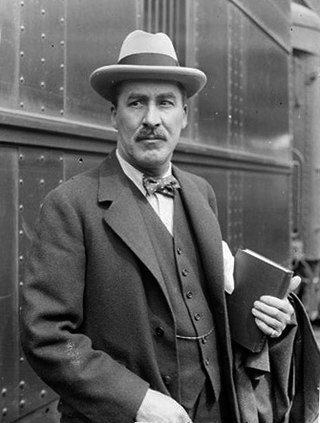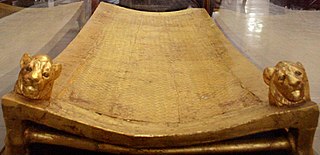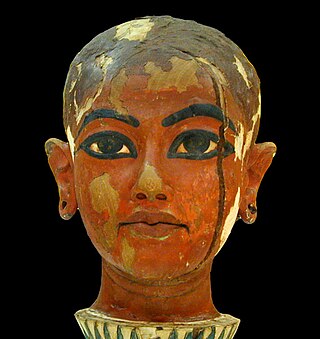
Howard Carter was a British archaeologist and Egyptologist who discovered the intact tomb of the 18th Dynasty Pharaoh Tutankhamun in November 1922, the best-preserved pharaonic tomb ever found in the Valley of the Kings.

Tutankhamun, Tutankhamon or Tutankhamen, also known as Tutankhaten, was the antepenultimate pharaoh of the Eighteenth Dynasty of ancient Egypt. He ascended to the throne around the age of nine and reigned until his death around the age of nineteen. The most significant actions of his reign were reversing the societal changes enacted by his predecessor, Akhenaten, during the Amarna Period: Tutankhamun restored the traditional polytheistic form of ancient Egyptian religion, undoing the religious shift known as Atenism, and moved the royal court away from Akhenaten's capital, Amarna. Tutankhamun was one of few kings worshipped as a deity during his lifetime; this was usually done posthumously for most pharaohs. In popular culture, he is known for his vastly opulent wealth found during the 1922 discovery of his tomb, KV62, the only such tomb to date to have been found in near-intact condition. The discovery of his tomb is widely considered one of the greatest archaeological discoveries of all time.

The Royal Academy of Arts (RA) is an art institution based in Burlington House on Piccadilly in London. Founded in 1768, it has a unique position as an independent, privately funded institution led by eminent artists and architects. Its purpose is to promote the creation, enjoyment and appreciation of the visual arts through exhibitions, education and debate.

Sir Edward Coley Burne-Jones, 1st Baronet, was a British painter and designer associated with the Pre-Raphaelite Brotherhood which included Dante Gabriel Rossetti, John Millais, Ford Madox Brown and William Holman Hunt. Burne-Jones worked with William Morris as a founding partner in Morris, Marshall, Faulkner & Co in the design of decorative arts.

The Egyptian Museum in Cairo, commonly known as simply the Egyptian Museum, located in Cairo, Egypt, houses the largest collection of Egyptian antiquities in the world. It houses over 120,000 items, with a representative amount on display. Located in a building built in 1901, it is the largest museum in Africa. Among its masterpieces are Pharaoh Tutankhamun's treasure, including its iconic gold burial mask, widely considered one of the best-known works of art in the world and a prominent symbol of ancient Egypt.

Penelope Mary Fitzgerald was a Booker Prize-winning novelist, poet, essayist and biographer from Lincoln, England. In 2008 The Times listed her among "the 50 greatest British writers since 1945". The Observer in 2012 placed her final novel, The Blue Flower, among "the ten best historical novels". A.S. Byatt called her, "Jane Austen’s nearest heir for precision and invention."

The National Portrait Gallery (NPG) is an art gallery in London housing a collection of portraits of historically important and famous British people. It was arguably the first national public gallery dedicated to portraits in the world when it opened in 1856. The gallery moved in 1896 to its current site at St Martin's Place, off Trafalgar Square, and adjoining the National Gallery. It has been expanded twice since then. The National Portrait Gallery also has regional outposts at Beningbrough Hall in Yorkshire and Montacute House in Somerset. It is unconnected to the Scottish National Portrait Gallery in Edinburgh, with which its remit overlaps. The gallery is a non-departmental public body sponsored by the Department for Digital, Culture, Media and Sport.

Admiral of the Red James Saumarez, 1st Baron de Saumarez, GCB was an admiral of the British Royal Navy, known for his victory at the Second Battle of Algeciras.

Thomas Pearsall Field Hoving was an American museum executive and consultant and the director of the Metropolitan Museum of Art.
Sir Charles Robert Saumarez Smith is a British cultural historian specialising in the history of art, design and architecture. He was the Secretary and Chief Executive of the Royal Academy of Arts in London from 2007 until he stepped down in 2018. He was replaced by Axel Rϋger, who took up the position in 2019.
Dame Hermione Lee, is a British biographer, literary critic and academic. She is a former President of Wolfson College, Oxford, and a former Goldsmiths' Professor of English Literature in the University of Oxford and Professorial Fellow of New College. She is a Fellow of the British Academy and of the Royal Society of Literature.

Peter De Wint was an English landscape painter. A number of his pictures are in the National Gallery, the Victoria and Albert Museum and The Collection, Lincoln. He died in London.
Bad Dog is an animated series produced by CinéGroupe and Saban Entertainment for the Teletoon and Fox Family Channel networks, first airing on Teletoon on March 1, 1999. The cartoon focused on the Potanski family and their dog Berkeley. The show's gimmick was that, whenever Berkeley was told that he was a bad dog, he would freeze and pretend to be dead until someone told him he was a good dog.

Exhibitions of artifacts from the tomb of Tutankhamun have been held at museums in several countries, notably the United Kingdom, Soviet Union, United States, Canada, Japan, and France.

Alexander Munro was a British sculptor of the Pre-Raphaelite movement. He concentrated on portraiture and statues, but is best known for his Rossetti-influenced figure-group Paolo and Francesca (1852), which has often been identified as the epitome of Pre-Raphaelite sculpture.

Margaret Sarah Carpenter was an English painter. Noted in her time, she mostly painted portraits in the manner of Sir Thomas Lawrence. She was a close friend of Richard Parkes Bonington.

Wilhelmina Weber Furlong (1878–1962) was a German American artist and teacher.

The Head of Nefertem was found in the tomb of Tutankhamun (KV62) in the Valley of the Kings in West Thebes. It depicts the King (Pharaoh) as a child and dates from the 18th Dynasty. The object received the find number of 8 and today is displayed with the inventory number JE 60723 in the Egyptian Museum in Cairo.
David P. Silverman is an American archaeologist and Egyptologist. He received an undergraduate degree from Rutgers University where he majored in art history. He later studied Egyptology as a graduate student at the University of Chicago where he received his PhD. Shortly after, he took a position at the international Treasures of Tutankhamun exhibit which originally ran from 1977 to 1982, and continued to work as curator on subsequent exhibits. Following this, he continued working at a variety of institutions including the Field Museum in Chicago. Since 1996, he has been Eckley Brinton Coxe, Jr. Professor of Egyptology at the University of Pennsylvania and head curator of the University of Pennsylvania Museum of Archaeology and Anthropology's Egyptian section. Alongside this, he currently teaches an online course through Coursera called Introduction to Ancient Egypt and Its Civilization. Some of his archaeological work has included excavations at Bersheh and Saqqara.

Lady Evelyn Leonora Almina Beauchamp, always known to the family as Eve, was the daughter of George Herbert, 5th Earl of Carnarvon. In November 1922, she, her father and the archaeologist Howard Carter were the first people in modern times to enter the tomb of the Egyptian Pharaoh Tutankhamun. She later married Sir Brograve Beauchamp and had a daughter. Lady Evelyn died in 1980, at the age of 78.
















